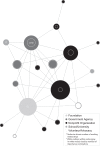The Structure of Policy Networks for Injury and Violence Prevention in 15 US Cities
- PMID: 28426291
- PMCID: PMC5415265
- DOI: 10.1177/0033354917705367
The Structure of Policy Networks for Injury and Violence Prevention in 15 US Cities
Abstract
Objectives: Changes in policy can reduce violence and injury; however, little is known about how partnerships among organizations influence policy development, adoption, and implementation. To understand partnerships among organizations working on injury and violence prevention (IVP) policy, we examined IVP policy networks in 15 large US cities.
Methods: In summer 2014, we recruited 15 local health departments (LHDs) to participate in the study. They identified an average of 28.9 local partners (SD = 10.2) working on IVP policy. In late 2014, we sent survey questionnaires to 434 organizations, including the 15 LHDs and their local partners, about their partnerships and the importance of each organization to local IVP policy efforts; 319 participated. We used network methods to examine the composition and structure of the policy networks.
Results: Each IVP policy network included the LHD and an average of 21.3 (SD = 6.9) local partners. On average, nonprofit organizations constituted 50.7% of networks, followed by government agencies (26.3%), schools and universities (11.8%), coalitions (11.2%), voluntary organizations (9.6%), hospitals (8.5%), foundations (2.2%), and for-profit organizations (0.7%). Government agencies were perceived as important by the highest proportion of partners. Perceived importance was significantly associated with forming partnerships in most networks; odds ratios ranged from 1.07 (95% CI, 1.02-1.13) to 2.35 (95% CI, 1.68-3.28). Organization type was significantly associated with partnership formation in most networks after controlling for an organization's importance to the network.
Conclusions: Several strategies could strengthen local IVP policy networks, including (1) developing connections with partners from sectors that are not well integrated into the networks and (2) encouraging indirect or less formal connections with important but missing partners and partner types.
Keywords: injury and violence prevention; organizational network; policy.
Conflict of interest statement
Figures



Similar articles
-
Multisector Health Policy Networks in 15 Large US Cities.J Public Health Manag Pract. 2016 Nov-Dec;22(6):520-8. doi: 10.1097/PHH.0000000000000401. J Public Health Manag Pract. 2016. PMID: 26910868 Free PMC article.
-
Assessing Injury and Violence Prevention in North Carolina's Local Health Departments.N C Med J. 2016 Sep-Oct;77(5):308-13. doi: 10.18043/ncm.77.5.308. N C Med J. 2016. PMID: 27621337 Free PMC article.
-
Effectiveness of anonymised information sharing and use in health service, police, and local government partnership for preventing violence related injury: experimental study and time series analysis.BMJ. 2011 Jun 16;342:d3313. doi: 10.1136/bmj.d3313. BMJ. 2011. PMID: 21680632 Free PMC article.
-
A Content Analysis of Hospitals' Community Health Needs Assessments in the Most Violent U.S. Cities.J Community Health. 2018 Apr;43(2):259-262. doi: 10.1007/s10900-017-0413-9. J Community Health. 2018. PMID: 28852912 Review.
-
The national improvement partnership network: state-based partnerships that improve primary care quality.Acad Pediatr. 2013 Nov-Dec;13(6 Suppl):S84-94. doi: 10.1016/j.acap.2013.04.001. Acad Pediatr. 2013. PMID: 24268091 Review.
Cited by
-
Analyzing mechanisms of interdisciplinary cooperation in promoting students' health at university.BMC Public Health. 2023 Oct 3;23(1):1911. doi: 10.1186/s12889-023-16786-2. BMC Public Health. 2023. PMID: 37789303 Free PMC article.
-
Intersectoral violence prevention: the potential of public health-criminal justice partnerships.Health Promot Int. 2022 Jun 1;37(3):daac062. doi: 10.1093/heapro/daac062. Health Promot Int. 2022. PMID: 35788309 Free PMC article.
References
-
- Mouzakes J, Koltai PJ, Kuhar S, et al. The impact of airbags and seat belts on the incidence and severity of maxillofacial injuries in automobile accidents in New York State. Arch Otolaryngol Head Neck Surg. 2001;127(10):1189–1193. - PubMed
-
- Brown MJ. Costs and benefits of enforcing housing policies to prevent childhood lead poisoning. Med Decis Making. 2002;22(6):482–492. - PubMed
MeSH terms
LinkOut - more resources
Full Text Sources
Other Literature Sources
Medical

